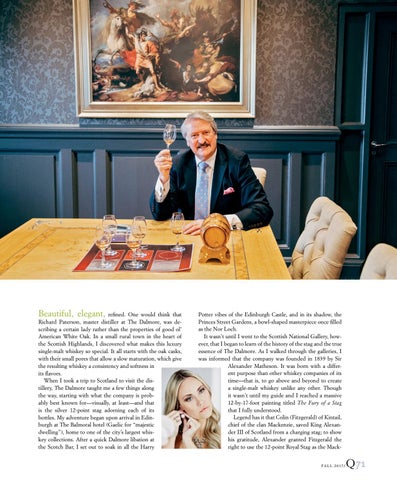Q U I N T E S S E N T I A L
Beautiful, elegant, refined. One would think that Richard Paterson, master distiller at The Dalmore, was describing a certain lady rather than the properties of good ol’ American White Oak. In a small rural town in the heart of the Scottish Highlands, I discovered what makes this luxury single-malt whiskey so special. It all starts with the oak casks, with their small pores that allow a slow maturation, which give the resulting whiskey a consistency and softness in its flavors. When I took a trip to Scotland to visit the distillery, The Dalmore taught me a few things along the way, starting with what the company is probably best known for—visually, at least—and that is the silver 12-point stag adorning each of its bottles. My adventure began upon arrival in Edinburgh at The Balmoral hotel (Gaelic for “majestic dwelling”), home to one of the city’s largest whiskey collections. After a quick Dalmore libation at the Scotch Bar, I set out to soak in all the Harry
S T Y L E
Potter vibes of the Edinburgh Castle, and in its shadow, the Princes Street Gardens, a bowl-shaped masterpiece once filled as the Nor Loch. It wasn’t until I went to the Scottish National Gallery, however, that I began to learn of the history of the stag and the true essence of The Dalmore. As I walked through the galleries, I was informed that the company was founded in 1839 by Sir Alexander Matheson. It was born with a different purpose than other whiskey companies of its time—that is, to go above and beyond to create a single-malt whiskey unlike any other. Though it wasn’t until my guide and I reached a massive 12-by-17-foot painting titled The Fury of a Stag that I fully understood. Legend has it that Colin (Fitzgerald) of Kintail, chief of the clan Mackenzie, saved King Alexander III of Scotland from a charging stag; to show his gratitude, Alexander granted Fitzgerald the right to use the 12-point Royal Stag as the MackFA L L 2 0 1 7 /
Q71
